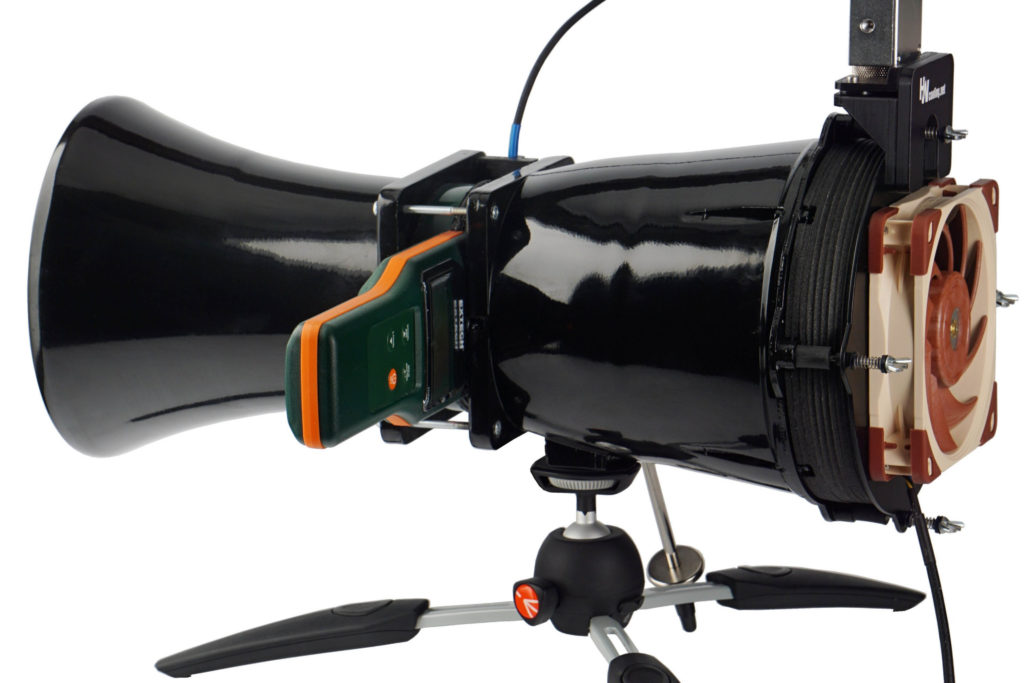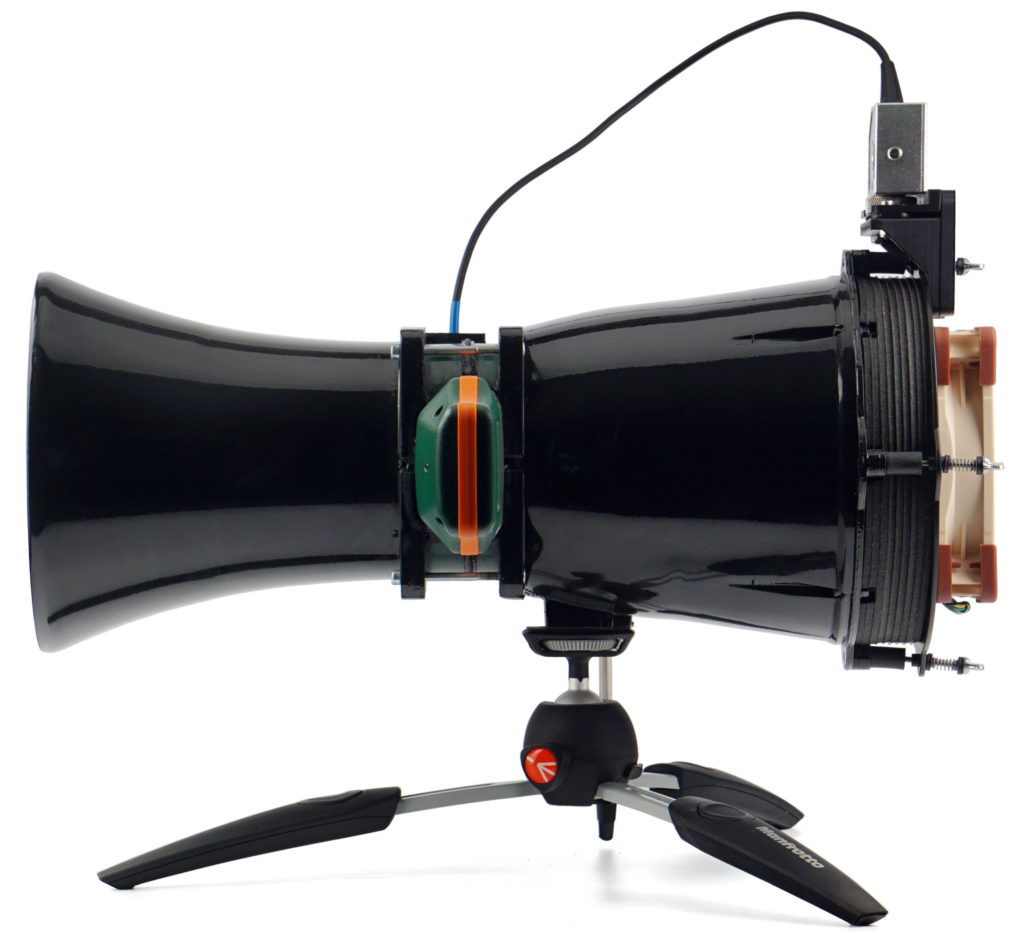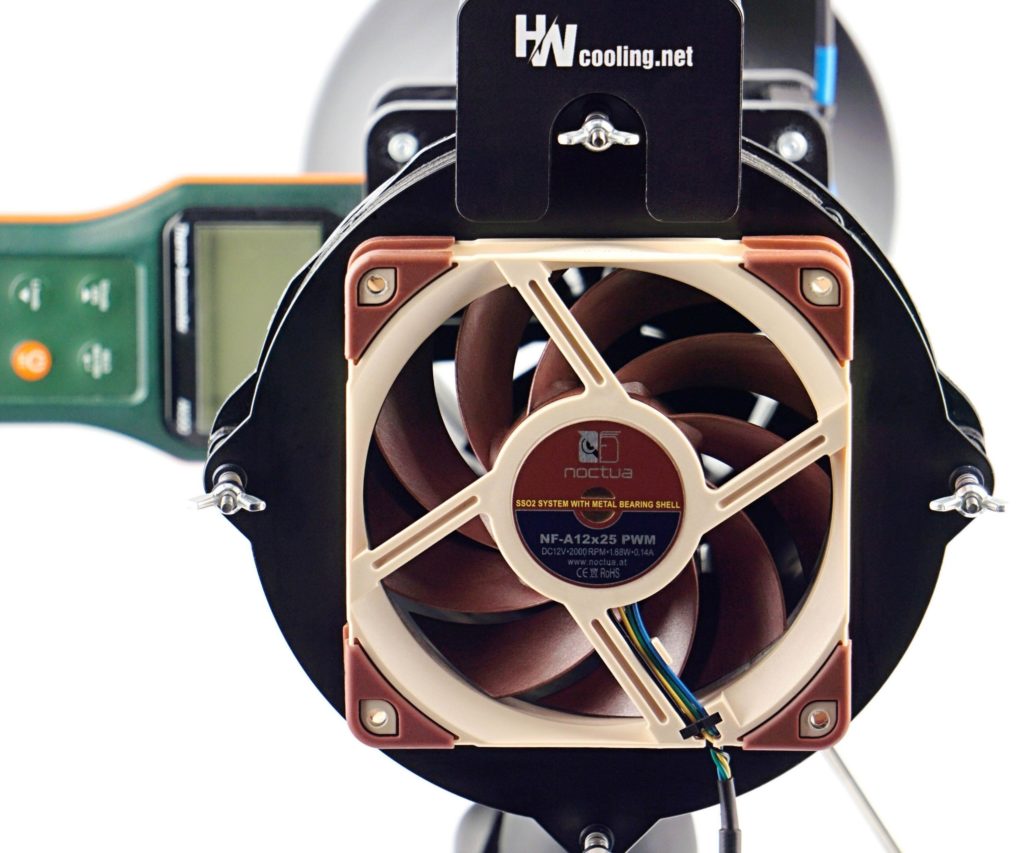Basis of the methodology, the wind tunnel
The first Fluctus 120 PWM fans marked a great qualitative progress in SilentiumPC production (now Endorfy). Nevertheless, they had their flaws, which the developers are gradually eliminating and, based on the measurement results, the newer 140 mm Fluctus can be said to be a clear improvement. The Fluctus 140 PWM ARGB stands out nicely from other fans in its price category.
The basis of the methodology, the wind tunnel
Before you start reading the methodology with all the details, take a look at the test tunnel as a whole. This is the heart of the whole system, to which other arteries are connected (manometer, vibrometer, powermeter, …). The only solid part of the tunnel from the measuring instruments is the anemometer.
The shape of the wind tunnel is inspired by the Venturi tube, which has long been used to measure the flow of liquids and gasses. The Venturi effect for wind speed measuring is also known from the aerospace industry. However, the design for measuring computer fans has its own specificities, which this proposal of ours reflects.
The individual parameters of the HWC wind tunnel for fan tests are the result of physical simulations and practical debugging. All the details (folds, material or finish used) have a rationale behind them and are designed this way for a specific reason. We will discuss the individual design details in turn in the description of the sub-variable measurements.
Now we will briefly elaborate on some things that do not fit thematically into the text of the following chapters. Namely, for example, that the skeleton of the wind tunnel is the work of a 3D printer (PLA). The rough print was, of course, then thoroughly machined by grinding, fusing, polishing and varnishing. Especially important is the smooth finish of the interior walls.
When joining the individual parts, the emphasis was on making sure that they fit together flawlessly, that they were sealed flawlessly (we will come back to this when we describe the test procedures for pressure measurement), but also that the joints were not loosened by use. Everything is disassemblable for servicing purposes, but it is ensured that the properties are maintained during use and, for example, even under the stress of vibration. The threads are secured with either lock nuts or thread-locking fluid. It depends on which is more suitable in which place.
When the wind tunnel is not in use, it is enclosed in a dust-tight chamber. In addition to the technical equipment and its correct storage, it is also important for objective outputs that all measuring instruments are calibrated according to the standard. Without this, it would be impossible to stand behind your results and rely on the manufacturers’ specifications. Calibration protocols are therefore an important part of the methodology. Testing is carried out at an ambient air temperature of 21–21.3 °C, humidity is approximately 45 % (± 2 %).
Fans come to us for testing in at least two pieces of the same model. If the deviations of any of the measured values are greater than 5 %, we also work with a third or fourth sample and the average value is formed by the results of the fans that came out the most similar and the differences between them fit under 5 %.
- Contents
- Endorfy Fluctus 140 PWM ARGB in detail
- Basis of the methodology, the wind tunnel
- Mounting and vibration measurement
- Initial warm-up and speed recording
- Base 6 equal noise levels…
- ... and sound color (frequency characteristic)
- Static pressure measurement…
- … and airflow
- Everything changes with obstacles
- How we measure power draw and motor power
- Measuring the intensity (and power draw) of lighting
- Results: Speed
- Results: Airlow w/o obstacles
- Results: Airflow through a nylon filter
- Results: Airflow through a plastic filter
- Results: Airflow through a hexagonal grille
- Results: Airflow through a thinner radiator
- Results: Airflow through a thicker radiator
- Results: Static pressure w/o obstacles
- Results: Static pressure through a nylon filter
- Results: Static pressure through a plastic filter
- Results: Static pressure through a hexagonal grille
- Results: Static pressure through a thinner radiator
- Results: Static pressure through a thicker radiator
- Results: Static pressure, efficiency by orientation
- Reality vs. specifications
- Results: Frequency response of sound w/o obstacles
- Results: Frequency response of sound with a dust filter
- Results: Frequency response of sound with a hexagonal grille
- Results: Frequency response of sound with a radiator
- Results: Vibration, in total (3D vector length)
- Results: Vibration, X-axis
- Results: Vibration, Y-axis
- Results: Vibration, Z-axis
- Results: Power draw (and motor power)
- Results: Cooling performance per watt, airflow
- Results: Cooling performance per watt, static pressure
- Airflow per euro
- Static pressure per euro
- Results: Lighting – LED luminance and power draw
- Results: LED to motor power draw ratio
- Evaluation












I have several general questions.
I see how the exhaust airflow pattern is often commended on. By how much does airflow pattern affect cooling performance? For example, assuming two fans have identical airflow rate on a thin radiator. One fan has cylindrical exhaust while the other has conical exhaust. Alternatively, one has a larger fan hub and the other has a smaller one. Or just different blade design in general. Does cooling performance differ, and if so, by how much? How about for case fans? How about on the intake side, does airflow pattern differ there?
The wind tunnel is made free of dust before testing. By how much does dust settled on the wind tunnel/fan blades etc affect airflow and noise? Would a thin layer significantly affect the results?
Great questions. We have had the ones from the first paragraph jotted down for a while and we will deal with them later in specialized tests. We just have to work our way through the other topics. 🙂
As for the effect of fan “dirtiness” on air flow, I wonder how this could be tested. Of course, we keep the wind tunnel as clean as possible (it is even stored in a vacuum chamber) and I don’t think it is a good idea to risk changing the friction or reducing the anemometer speed by some sediments from the tested fan. But we’ll figure something out. For this purpose we could use some of the prototype tunnels that preceded the final one we are using. They have some imperfections, but they should be suitable for this purpose.
I’m in love with these deeply scientific reviews. No other reviewer, ever, anywhere, went to such lengths and details in their reviews, especially about pc fans. Because of them I’m getting now 2x Endrofy Fluctus 140 argb for a top exhaust on case with grill+ dust filter. Having read all other reviews, I do prefer them over Pure Wings 3, they seem to be more efficient and more quiet at similar settings.
Thank you!